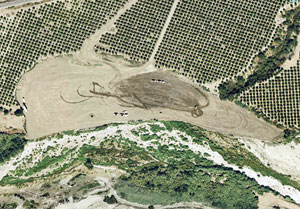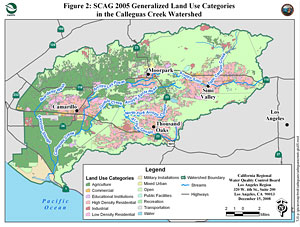Pacific Southwest, Region 9
Serving: Arizona, California, Hawaii, Nevada, Pacific Islands, Tribal Nations
Restoring Calleguas Creek
The Calleguas Creek watershed consists of 343 square miles in Southern California. This greater watershed is made of up 7 sub-watersheds at the 12 digit HUC (hydrologic unit code) scale. Undeveloped areas account for 50% of the land in the greater watershed while 25% is urban, and 25% is agricultural. Most of the urban areas, including the communities of Moorpark, Simi Valley and Thousand Oaks are located in the upper sub-watershed and most of the agriculture is located in the middle and lower sub-watersheds.

Calleguas Creek (Arroyo Las Posas) at the Staben Site after the fill.
Source: Airphoto USA, September 1, 2005
Larger view

Calleguas Creek (Arroyo Las Posas) at the Staben Site prior to the fill.
Source: Airphoto USA, September 1, 2004
Larger view
Ventura County Contractor to Pay $225,000 for Illegal Dumping into Calleguas Creek
Thomas Staben will also spend at least $500,000 to restore 5 acres of the creek, create 2 acres of vegetated buffer, and fund a stream rehabilitation project.
SAN FRANCISCO –A Ventura County contractor, Thomas Staben, and his construction company, TA Staben, Inc., will pay a $225,000 penalty for illegally dumping imported material into a Ventura County creek. Thomas Staben illegally filled Calleguas Creek with 40,000 cubic yards of material - the equivalent of about 2,000 large dump truck loads. As part of the settlement, Staben will also spend at least $500,000 on restoration and mitigation projects, including removing the fill and restoring the creek’s natural functions. Calleguas Creek is the main freshwater source for the Mugu Lagoon Estuary, one of Southern California’s largest coastal wetland systems and home to various endangered species.
“Restoring Calleguas Creek is a win for the environment and for the local community,” said Jared Blumenfeld, EPA’s Regional Administrator for the Pacific Southwest. “Today’s settlement signals EPA’s commitment to protect coastal California’s watersheds, and sends a strong message to those who would despoil them.”
Between 2005 and 2006, Staben filled approximately five acres of Calleguas Creek, also known as Arroyo Las Posas, without the necessary Clean Water Act (CWA) permit despite several warnings by the Army Corps of Engineers to stop. The illegal fill substantially reduced the active floodplain in this portion of the creek, increasing potential flooding of adjacent properties and contributing to the bioaccumulation problems harmful to the health of endangered species and other wildlife in Mugu Lagoon. Staben, who has a history of noncompliance dating back to 1989, was cited by the Corps on various occasions for unpermitted work in Calleguas Creek and the Ventura River.
The creek has been the subject of extensive studies and protection efforts at federal, state, and local levels due to its ecological significance and impaired water quality. As part of the restoration project Staben will remove the illegal fill material, restore the five acres of filled active floodplain, and create another two acres of vegetated embankment buffer between the floodplain and the upland property. Restoration will allow the creek to perform the important ecological functions of recharging groundwater, retaining nutrients, attenuating floodwaters, and providing habitats and movement corridors for wildlife. The project will also address long-term erosion problems of the adjacent property and reduce non-point source pollution.
Staben will also spend $150,000 on mitigation by paying into the Ventura River Watershed Habitat Restoration Fund to help fund the Rice Creek Re-Alignment Project, which aims to create about 9 acres of new stream habitats and help maintain water quality for steelhead in the downstream Ventura River.
The CWA protects the nation’s coasts, rivers, lakes, streams, and wetlands, which are vital to the protection of human health and the environment. Section 404 of the CWA requires anyone who proposes to fill and alter protected waterways, including wetlands, with dredged or fill material to first obtain permit authorization from the U.S. Army Corps of Engineers.
The proposed consent decree for the settlement, lodged with the federal district court on December 30, 2011, is subject to a 30-day comment period and final court approval. A copy of the proposed decree is available on the Justice Department website.
| Pacific Southwest NewsroomPacific Southwest Programs | Grants & FundingUS-Mexico Border | Media Center Careers | About EPA Region 9 (Pacific Southwest)A-Z Index |

